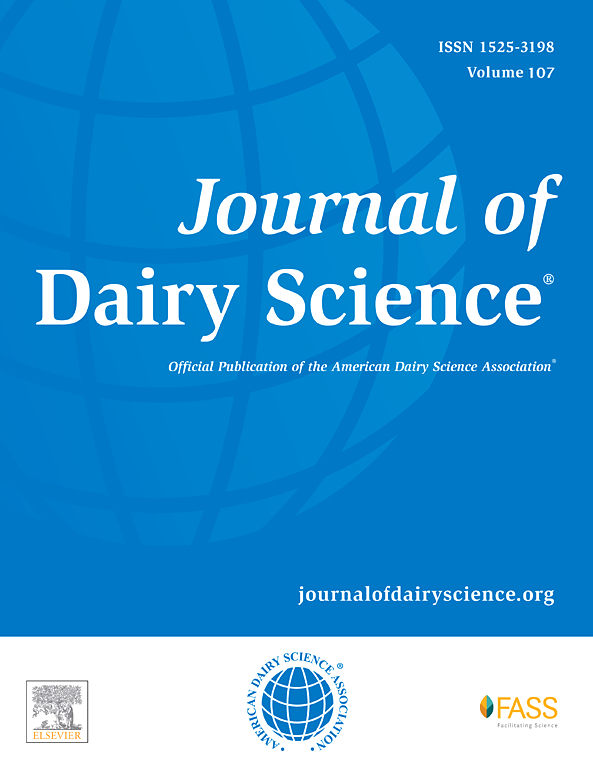Circulating progesterone concentrations and pregnancy outcomes in high-producing lactating dairy cows treated with human chorionic gonadotropin on day 2 of the estrus cycle
IF 3.7
1区 农林科学
Q1 AGRICULTURE, DAIRY & ANIMAL SCIENCE
引用次数: 0
Abstract
Suboptimal concentrations of circulating progesterone (P4) in the early postovulatory period have been associated with low fertility observed in high-producing lactating dairy cows. The administration of human chorionic gonadotropin (hCG) increases P4 in cattle by stimulating its endogenous production by the corpus luteum (CL) and creating an accessory CL if administered at an appropriate stage of the cycle. The aim of this study was to evaluate the effect of a single administration of hCG on d 2 of the estrus cycle on circulating P4 concentrations and pregnancy per artificial insemination (P/AI) in high-producing lactating dairy cows in confinement systems. To that end, 796 lactating Holstein-Friesian dairy cows from 15 farms were enrolled on this study. The mean ± SD parity and DIM at enrollment were 2.3 ± 1.4 and 86.7 ± 17.8, respectively. After a voluntary waiting period (50–60 d after calving), cows underwent fixed-time artificial insemination (FTAI) following a routine protocol for synchronization of ovulation (Double Ovsynch, G6G, or 7-d Ovsynch + P4). Cows on each farm were blocked on parity, DIM, BCS, and synchronization protocol and were randomly assigned to receive either 3,000 IU of hCG (n = 420) or an equivalent volume of saline solution (control; n = 376) on d 2 after estimated estrus (∼16 h before FTAI = d 0). Blood samples were collected from a subset of cows from both treatments (control n = 65 and hCG n = 65) on d 0, 7, and 14 of the estrus cycle to measure serum P4 concentrations. Pregnancy per artificial insemination on d 30 after FTAI was affected by hCG treatment and parity. Moreover, there was a tendency for an interaction between treatment and parity. Overall, treatment with hCG on d 2 of the estrus cycle increased P/AI (45.2% vs. control 38.8%). In first- or second-lactation cows, P/AI was similar between hCG-treated and control cows (47.1% vs. control 45.9%). Conversely, cows in third or greater lactation treated with hCG had greater P/AI (42.1% vs. control 27.3%). The overall incidence of pregnancy loss between d 30 and d 70 was 14.7% and was not affected by treatment. Cows treated with hCG had higher P4 concentrations on d 7 and 14 compared with control cows (3.4 ± 0.66 vs. 3.0 ± 0.58 ng/mL and 6.6 ± 1.28 vs. 5.3 ± 1.02 ng/mL, respectively). Moreover, an interaction between treatment and parity revealed that P4 concentrations were higher in hCG-treated cows in third or greater lactation compared with control cows in the same parity group on d 7 and 14, while no differences were observed in first- or second-lactation cows. In conclusion, administration of hCG on d 2 of the estrus cycle increased fertility in high-producing dairy cows in third or greater lactation, in association with an early increase of circulating P4.
人绒毛膜促性腺激素对高产泌乳奶牛发情周期第2天循环孕酮浓度和妊娠结局的影响
在高产泌乳奶牛中,排卵后早期循环孕酮(P4)浓度不佳与低生育率有关。人绒毛膜促性腺激素(hCG)通过刺激黄体(CL)内源性P4的产生和在周期的适当阶段产生辅助CL来增加牛P4。本研究旨在评价发情周期第2天单次给药促性腺激素(hCG)对产奶期高产泌乳奶牛循环P4浓度和人工授精妊娠率(P/AI)的影响。为此,本研究招募了来自15个农场的796头泌乳荷斯坦-弗里西亚奶牛。入组时的平均±SD胎次和DIM分别为2.3±1.4和86.7±17.8。在自愿等待期(产犊后50-60 d)后,奶牛按照常规的同步排卵方案(双ovsync, G6G,或7 d ovsync + P4)进行固定时间人工授精(FTAI)。每个农场的奶牛按胎次、DIM、BCS和同步方案进行分组,随机分配接受3000 IU hCG (n = 420)或等量生理盐水(对照组;n = 376)在估计发情后第2天(FTAI =第0天前~16小时)。在发情周期的第0、7和14天,分别从两组奶牛(对照组n = 65和hCG n = 65)中采集血液样本,测量血清P4浓度。FTAI后第30天每AI妊娠受hCG治疗和胎次影响。此外,在待遇和平等之间有相互作用的趋势。总体而言,在发情周期第2天使用hCG可提高P/AI (45.2% vs.对照组38.8%)。在≤2泌乳奶牛中,hcg处理的P/AI与对照组相似(47.1% vs. 45.9%)。相反,hCG处理的第3期奶牛的P/AI更高(42.1%,对照组27.3%)。妊娠30 ~ 70天的总流产率为14.7%,不受治疗影响。hCG处理奶牛在第7天和第14天的P4浓度高于对照组(分别为3.4±0.66比3.0±0.58 ng/mL和6.6±1.28比5.3±1.02 ng/mL)。此外,处理与胎次的交互作用表明,在第7天和第14天,hcg处理≥3泌乳奶牛的P4浓度高于同胎次组的对照奶牛,而≤2泌乳奶牛的P4浓度无显著差异。综上所述,在发情周期第2天给予hCG可提高泌乳≥3次的高产奶牛的生育能力,并与循环P4的早期升高有关。
本文章由计算机程序翻译,如有差异,请以英文原文为准。
求助全文
约1分钟内获得全文
求助全文
来源期刊

Journal of Dairy Science
农林科学-奶制品与动物科学
CiteScore
7.90
自引率
17.10%
发文量
784
审稿时长
4.2 months
期刊介绍:
The official journal of the American Dairy Science Association®, Journal of Dairy Science® (JDS) is the leading peer-reviewed general dairy research journal in the world. JDS readers represent education, industry, and government agencies in more than 70 countries with interests in biochemistry, breeding, economics, engineering, environment, food science, genetics, microbiology, nutrition, pathology, physiology, processing, public health, quality assurance, and sanitation.
 求助内容:
求助内容: 应助结果提醒方式:
应助结果提醒方式:


